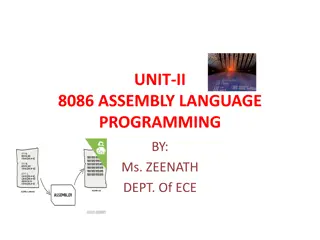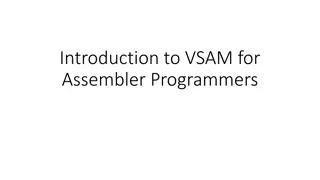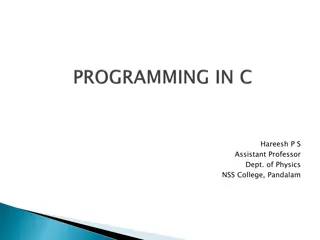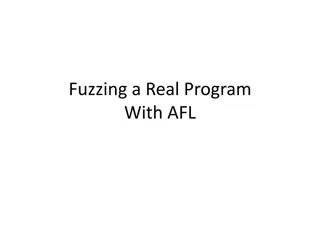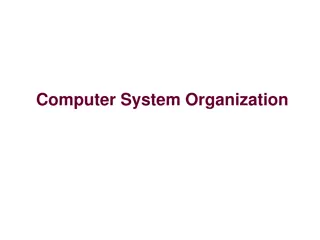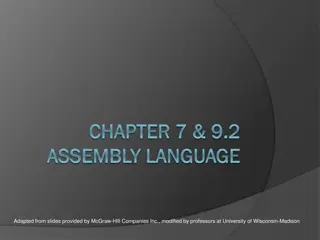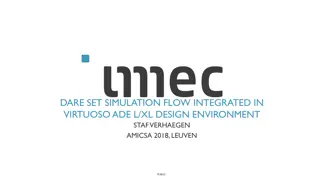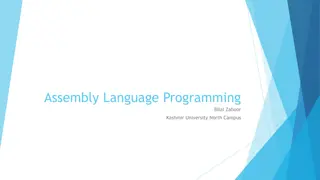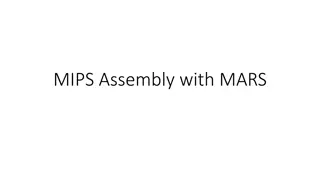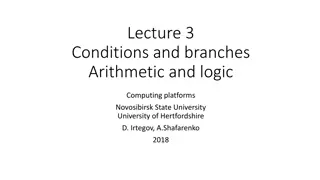Introduction to Assembly Language Syntax and Program Data
Learn about the syntax of assembly language and how data, variables, and constants are used in programming. Explore the basic instructions and the translation of high-level language into assembly language. Discover the role of an assembler in translating assembly language programs into machine langu
5 views • 36 slides
Assembler Directives and Symbols in Assembly Language
Assembly language is a low-level programming language used for computers, microprocessors, microcontrollers, and ICs. It consists of instructions and directives (pseudo instructions). Assembler directives are statements that guide the assembler during the assembly process. Categories of directives i
4 views • 39 slides
Introduction to 8086 Assembly Language Programming
Assembler directives play a crucial role in guiding the assembly process for 8086 assembly language programming. They dictate how operands are handled, memory organization, and more. This content covers essential directives such as ASSUME, DB, DW, DD, DQ, and DT, providing syntax examples and explan
4 views • 29 slides
VSAM: A Comprehensive Overview for Assembler Programmers
VSAM (Virtual Storage Access Method) is a crucial component in mainframe programming, offering various file types like ESDS, RRDS, and KSDS. VSAM data sets are organized into clusters, control areas, and control intervals for efficient data management. Control intervals and areas are dynamically man
6 views • 26 slides
Programming Languages: Levels and Basics
Programming languages facilitate communication between humans and computers, with machine language being the fundamental binary code understood by computers. Different levels of programming languages exist, from low-level machine language to high-level languages like C. Natural languages are meant f
2 views • 35 slides
Practical Guide to Fuzzing Programs with AFL
Explore the process of fuzzing a real program using American Fuzzy Lop (AFL) with NASM, a popular Netwide Assembler. Learn how to obtain AFL and NASM, create test samples, minimize samples, start the fuzzer, and receive tips for successful fuzzing. Embrace the journey that may take days, weeks, or e
2 views • 8 slides
Computer System Organization and Compilation Process
Explore the intricate details of computer system organization, the compilation process, and the role of components like the preprocessor, compiler, assembler, and linker. Learn how programs are processed and executed, from source code to executable code.
1 views • 47 slides
Assembly Language Programming
Assembly language provides a bridge between human-readable instructions and machine code, making it easier for programmers to interact with hardware. This content covers the basics of assembly language syntax, opcodes, operands, and labels, as well as the role of the assembler in converting human-re
0 views • 74 slides
Advanced Simulation Integration in Virtuoso Design Environment
Explore the seamless integration of simulation flows in the Virtuoso ADE L/XL design environment, showcased at AMICSA 2018 in Leuven. From DARE set simulations to Wish List features and historical advancements like SET Striker Verilog-A models, the presentation highlights the compatibility with ADE
0 views • 26 slides
Overview of Assembly Language Programming in 8086 Architecture
Assembly language programming in the 8086 architecture involves writing case-sensitive instructions represented by statements. Each statement corresponds to an 8086 instruction or an assembler directive. Instructions follow a specific format with optional components like labels and comments. Assembl
0 views • 31 slides
Introduction to MIPS Assembly Programming with MARS
Introduction to MIPS Assembly Programming with MARS including instructions, I-Type format, register initialization, addi instructions, and translation to machine code using an assembler. Learn how to perform basic arithmetic operations in MIPS assembly language.
0 views • 61 slides
Arithmetic and Logic Computing in CdM-8
Explore the fundamental concepts of arithmetic and logic computing, including conditions, branches, arithmetic instructions, logic instructions, shift and move instructions, and the practical applications of shift operations. Delve into CdM-8 flags semantics, C and unsigned subtraction/comparison, b
0 views • 14 slides


